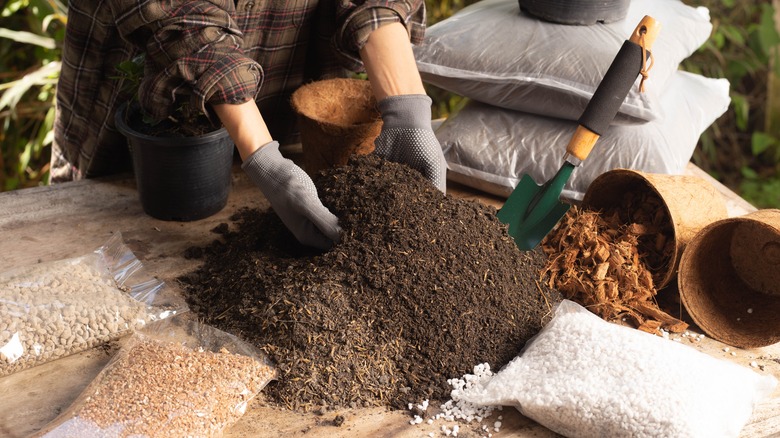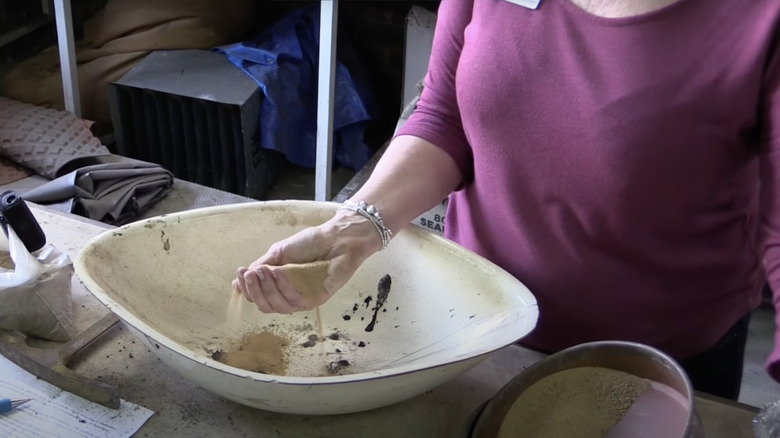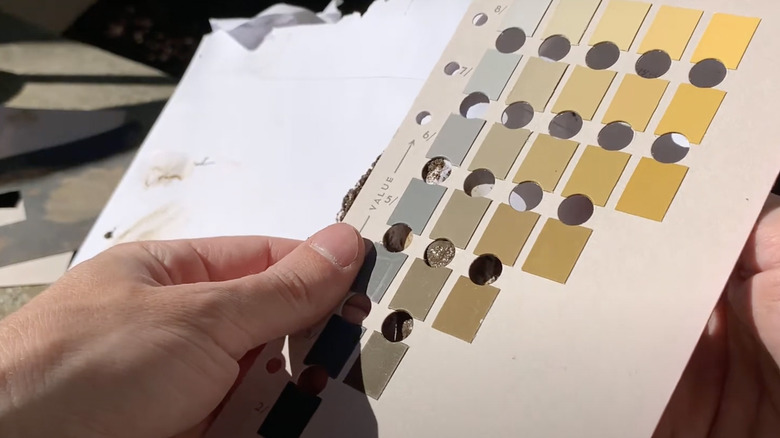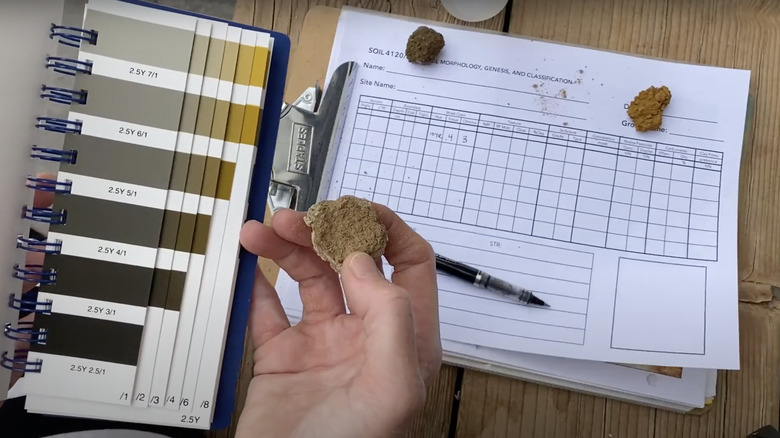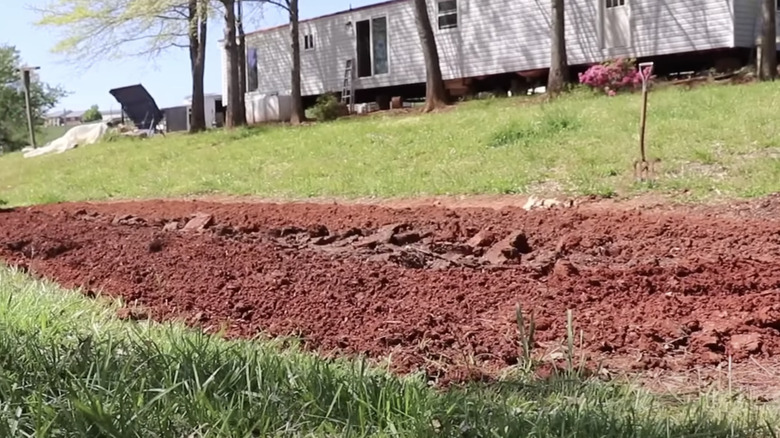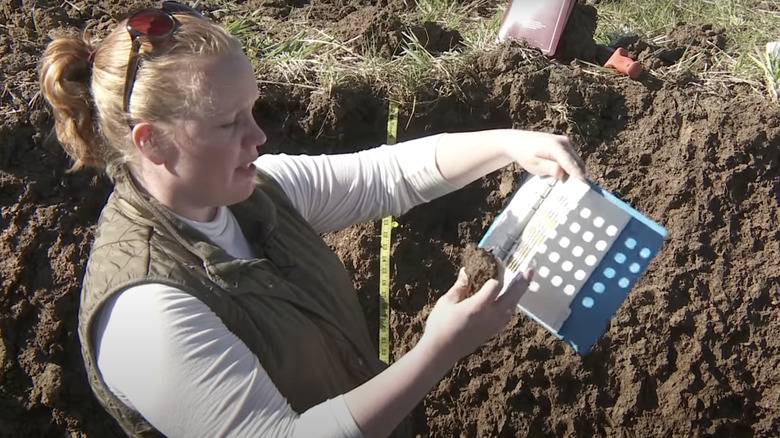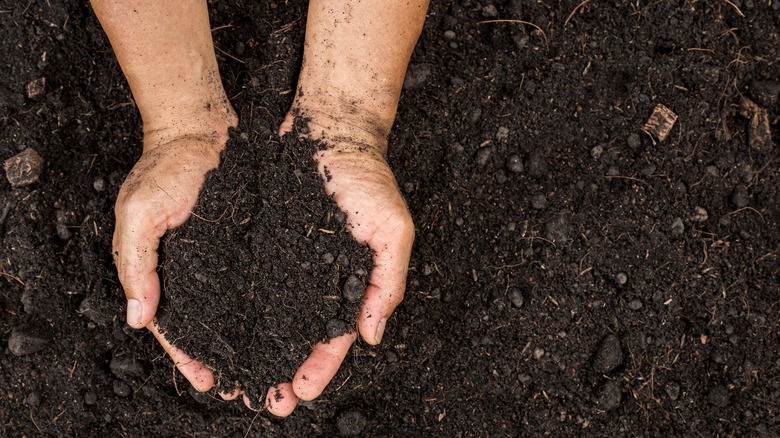Here's What The Color Of Your Garden Soil Is Trying To Tell You
The earth takes on many colors, and the appearance of soil ranges across different biomes. Although there are many shades of dirt, not all of them are optimal for growing trees, shrubs, flowers, and harvestable plants. Aspiring gardeners must classify and understand the foundation of their gardens, starting with the very soil they're planting in.
Dirt color varies from pale and colorless to so dark it appears black. The shade is not as inconsequential as you might think — it reveals much about the mineral content, organic matter, and moisture levels within the ground. These colors are so crucial to know that they are classified on an official system known as the "Munsell Color System."
The Munsell Color System serves as a reference for soil colors worldwide. It compares their hue color, light or darkness level, and intensity. Understanding the color of your soil cues you on how it compares to the local environment and what plants can thrive within. Identify the color of your garden soil and learn more about what this means for your planting enterprises below.
Colorless soil provides no nutrients
If you can describe your soil as off-white, colorless, or pale, it's probably not the best spot to start raising plants. White topsoil is usually sand (also known as silica), which is eroded material from the nearby landscape. It has no nutritional value and doesn't nurture plant life.
You may also come across light-colored subsoil layers deeper in the ground. This is not the same as silica topsoil, but indicates that lower soil levels are altered by calcium carbonate, or limestone. High concentrations of calcium carbonate are naturally washed away by rain. Therefore, if you find bleached soil, it's likely your yard doesn't have good drainage.
On a side note, white soil isn't all bad. Many gardeners use sand to make their soil more well-draining. Sand has more air pockets than dirt, which allows water to quickly run through it, keeping it from soaking into plant roots and overwatering them. However, you don't want to overdo it. Hartley Botanic recommends only using 1 part sand for every 5 parts of nutritional soil. As discussed earlier, mixtures of closer proportions are inhospitable for most roots, making it difficult to grow flowers, trees, and even grass.
Green and gray soil teems with bacteria
There are good and bad bacteria present in most soil samples. Aerobic bacteria live in topsoil and help decompose organic matter that plants later absorb. In contrast, anaerobic bacteria create toxic compounds that stunt root growth and make plants vulnerable to diseases. When soil loses its reddish tint and starts taking on gray and green tones, it's a strong indicator that anaerobic bacteria is running rampant. The more this bacteria spreads, the more it removes oxygen from the soil. Without oxygen, iron in the dirt is no longer oxidizing, leading to a physical change in color.
The grayish color can also indicate high sulfur levels in the soil. Sulfur is good in moderation, but anaerobic bacteria can cause excess, which leads to the aforementioned issues. Improving drainage, adding sand to dirt, reducing fertilizer, and cleaning up fallen leaves and twigs help balance out this problem.
Yellow soil needs more nutrients
Yellow soil can indicate varying issues, which change depending on its color vibrance. If dirt is on the paler side, the soil is leached of nutrients. However, if the yellow is a richer shade, it shows there are high amounts of iron oxide in the soil. Iron oxide is an important mineral that helps plants grow, and it often makes red and yellow soils more bright in appearance. While its presence is usually beneficial, plants won't thrive in soil devoid of other important nutrients too.
In fact, when yellow soil is submerged or has poor drainage, it can transform into green or gray colors. To avoid this, add organic matter to the soil to provide those missing nutrients. Look for organic mulches with tree leaves, grass clippings, or wood chips. Also scavenge for dead leaves and branches from around your yard and neighboring areas to introduce to your home ecosystem.
Although yellow soil isn't ideal, it may be adequate for raising hardier plant varieties. Mangoes, oranges, and potatoes are common fruits and vegetables grown under these conditions. Keep in mind that while they may grow, their harvests will not be bountiful compared to plants raised in healthier soil.
Red soil has its pros and cons
While all the soil colors described thus far have mostly been portrayed in a negative light, red soil isn't so black and white. Reddish-colored earth indicates high levels of iron oxide and clay and a very low pH. The low pH makes it highly acidic, which makes it suitable for growing berries, potatoes, leafy greens, and other fruits and vegetables. This soil is also home to several beautiful flowers, such as daylilies, black-eyed susans, and sedums.
When the red is a bright color, it means it's draining well and highly hospitable to acidic-favoring plants. You must keep in mind that not all reds are so nourishing. If the red color appears washed out and faded, there are few nutrients present. On the other hand, if the color is very dark, it may be oversaturated, which can lead to dangerous bacterial growth.
Lessen the red intensity by adding ground limestone, which interacts with other compounds to make the soil more alkaline. You can also make a darker color less saturated by improving drainage. In contrast, make a pale garden plot more vibrant by fertilizing or adding mulch.
Brown soil means you're on the right track
When most people envision dirt, they think of middle-toned brown earth that is dry and loosely packed together. This is the type of soil most gardeners start out with, as it contains moderate amounts of nutrients, minerals, and moisture. When you fix the previously discussed soil colors, they should fade to this even-toned brown, which then indicates garden plots are ready for planting.
Like all soil, it's important to ensure the brown tone isn't too faded, verging on a light tan shade. This beige coloring indicates your soil is relatively fertile, but it could use more organic matter to improve its coloring. In short, it has the potential to sustain plant life but won't be as ideal as a deeper brown. The subpar conditions are doable but may make it difficult to grow sensitive plants.
Deep brown soil is top-of-the-line (for most plants)
The epitome of perfect soil color is a deep brown, almost black. This type of soil is known in the gardening world as "Black Earth." Such sublime soil is coveted by gardeners all around the world. As a result, many retailers dye their soil with colorants to deceive buyers into thinking they are buying top-quality soil at incredible prices. In reality, black earth, or chernozem, isn't easy to come by.
The true version of this garden soil is rich in organic matter and the three most important minerals for plants: nitrogen, phosphorous, and potassium. In addition to its many nutritional benefits, this soil color also implies that the ground is well-watered, with plenty of moisture for gardening plants to absorb through their roots. However, like all soil varieties, there is a downside to this rich, dark color.
While all plants need nutrition, not all thrive in moist conditions. Succulents and certain herbs, fruits, and vegetables survive on scant water, and this type of soil can cause root rot and other plant diseases. Lavender, sage, tomatoes, peppers, pomegranates, and figs are just a few examples of plants that prefer desert-like conditions and won't thrive in this exemplary soil type.
